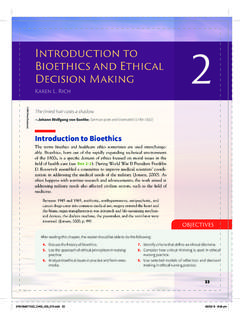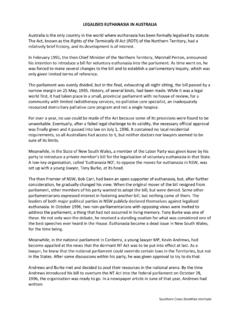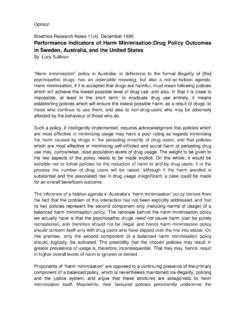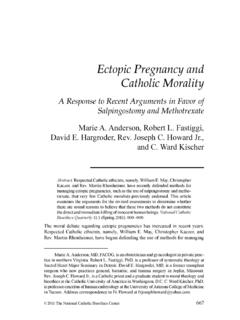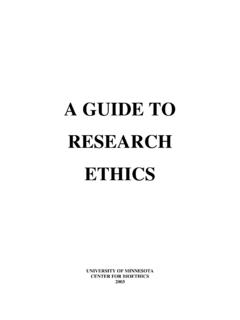Transcription of Ethical issues raised by genetically modified microorganisms
1 1 Ethical issues raised by genetically modified microorganisms Michel Gautier, Laboratory of Microbiology and Food Hygiene, UMR STLO 1253, Agrocampus, 65 rue de Saint Brieuc, 35042 RENNES CEDEX ( : all terms marked with an asterisk feature in the glossary at the end) Unlike experiments carried out on humans and animals, applications involving microorganisms and their genetic modification do not cause pain and suffering as generally understood. The Ethical problems raised by genetically modified microorganisms (GMMs) therefore mainly related to the impact they have on the Earth's biosphere. As microorganisms can be found everywhere, including in the ecological niches that are the most unsuited to life forms, the repercussions can be substantial and irreversible.. In order to clearly grasp to what extent GMMs can be dangerous for humans and their environment, it is necessary, on the one hand, to define them and explain the context in which they are used or can be potentially used (this will be the subject of the first part of this text) and on the other hand, to specify the possible risks of these uses (this will be the subject of the second part).
2 Next, having put these risks in perspective in the third part, we shall question the actual usefulness of these GMMs (can we do without them or not?) as, in the end, given the lack of knowledge currently available, the most effective way of solving this Ethical problem once and for all is perhaps to reduce their use. We will end with the role of researchers in the emergence of these new organisms that they cannot yet completely control. 1. What is a genetically modified organism? Which microorganisms are concerned? In a phylogenetic* tree featuring all living organisms, the majority of these (in terms of diversity) are microorganisms : one branch of this tree includes true bacteria (also known as eubacteria) whereas the other two branches consist of archaebacteria and eukaryotic* 2 microorganisms . These notably include protozoa, unicellular algae, and yeasts and moulds (Bapteste et al., 2004). Within these three main categories of microorganisms , it is bacteria that have undergone the most genetic modification.
3 However, within the eukaryotes, we do find moulds and yeasts that have also undergone genetic modification, although this is rarer. This text will not cover the problem of viruses which, as they are not autonomous and require another organism to multiply, need to be studied separately. What is a genetically modified organism? A microorganism is considered to be genetically modified if: - genetic material has been inserted into it by an unnatural method, other than natural conjugation, transformation or transduction. - genetic material that has been modified in vitro has been inserted into it. In this case, even if a natural transfer method has been used, the microorganism is still considered to be genetically modified . The gene that has been inserted into the bacteria can be homologous, it comes from the same species, or heterologous, in which case it has come from another species or bacterial genus ( cloning of a Bacillus thuringiensis gene encoding an insecticide in Pseudomonas) (Wilson and Lindow, 1993).
4 A heterologous gene can also come from an animal or plant cell ( cloning the gene encoding human insulin in Escherichia coli). DNA modified in vitro (foreign DNA) can be: - either inserted into a cloning vector, a set of genes capable of enabling the genes that have been transferred to the bacteria to replicate in it; in this case the foreign DNA includes the cloned gene and the often heterologous genes making up the cloning vector. - or inserted into the chromosome; in this case the foreign DNA is generally exclusively made up of the cloned gene. 3 In what cases can microorganisms and (a fortiori) genetically modified microorganisms be used? Are they useful? There are five categories in which microorganisms including or potentially including GMOs can be used. a) for producing molecules or biomass in a fermenter, b) for producing fermented foods, c) for various uses in the environment (in agriculture, for pollution control, etc.
5 , d) for producing strains for therapeutic purposes ( live vaccines), e) for gaining fundamental knowledge. With certain technologies, living microorganisms can be released into the environment where they may multiply. To guard against this risk, many countries have legislated against these GM technologies. Using microorganisms in a fermenter Since the mid-20th century, microorganisms have been widely used to produce numerous molecules required by the pharmaceutical, agri-food and chemical industries. Moreover, they are produced in fermenters to develop the starter cultures required by the fermented food industry. In the pharmaceutical industry, many molecules (such as antibiotics or vitamin B12, for instance) are produced by microorganisms which synthesise them naturally. There are also the even more numerous molecules whose gene has been cloned in a microorganism ( human insulin, growth hormone, Hepatitis B vaccine).
6 All these molecules have been marketed for many years and are part of developed countries' daily therapeutic arsenal (recombinant insulin has been produced since 1983) (Swartz, 2001). In the agri-food industry, intermediate products such as enzymes* ( amylases, rennin), amino acids*, organic acids and even nucleic acids* are produced by microorganisms . In the same way as above, these molecules can be naturally synthesised by microorganisms or come from GMMs. 4 Lastly, the chemical industry features many molecules (such as enzymes, organic acids and biofuels) produced by microorganisms . Producing molecules in a fermenter involves culturing the microorganism responsible for producing the required molecule in a (generally) confined space containing a suitable nutritive medium. This operation is generally performed in a confined atmosphere and, in theory, does not cause microorganisms to be released into the environment. It must meet Community requirements (European directives 90/219 and 98/81).
7 In order to master the technology, many GMM culture approvals have been granted over the past few decades (European directive 2001/18/EC). In theory, they are only granted once the risks to public health and the environment have been fully assessed. There is little diversity in microbial species that are genetically modified to produce useful molecules, as they are often model microorganisms that have been studied over a long period and for which the recombinant DNA technologies are very sophisticated and well-known. They include mainly bacteria ( E. coli (Baneyx, 1999), Bacillus subtilis) and yeasts (notably Saccharomyces cerevisiae) (Ostergaard et al., 2000). Producing fermented foods microorganisms are the main agents in the production of vast numbers of fermented foodstuffs. In Europe, many GMM strains used in this process have been available in research laboratories for a long time but are not yet used for legal reasons, unlike in the Bread, wine, cheese, butter, creme fraiche, yoghurts, kefir, fermented meats (dry-cured sausage, salami) and fermented vegetables (sauerkraut, olives) are produced by the action of an extremely varied microbial flora.
8 Some fermented foods are produced from a complex and little known microbial flora (that may be categorised as wild flora) found in raw materials and the environment (some unpasteurised cheeses, beers and sourdough bread); others are made from industrial starter cultures of simpler composition and identified flora (many cheeses made from pasteurised milk, for example) and lastly other fermented foodstuffs contain both complex wild flora and industrial flora, which has been added deliberately and in controlled 5 conditions (this is notably the case of fermented foodstuffs whose raw material cannot be sterilised, such as dry-cured sausage, etc.). Whatever the case, apart from the majority of fermented drinks and bread, at the end of fermentation fermented foods generally contain roughly 109 microorganisms /gram. Depending on the type of food, this flora may or may not be living when the food is ingested by the consumer.
9 Microbial flora then travels through the digestive tract and does not generally stay there, consequently ending up in the environment through faeces. Why use GMOs for fermented foods? Foods with complex flora are useful due to their elaborate organoleptic properties, but they can be the seat of pathogenic microorganism development. In addition, their production is difficult to control as microbial flora fluctuates according to the environmental conditions. On the other hand, foods with controlled flora are less useful from an organoleptic viewpoint but safer. For several years, in order to produce fermented products with controlled flora that are as advantageous from an organoleptic* viewpoint as wild flora-derived foods, industrialists have added new bacterial species isolated from wild flora-derived foods to their starter cultures. But until very recently, they were unable to guarantee that these new species were totally harmless, which thus raised doubts about the safety of these foods.
10 The use of GMMs to produce fermented foods would, on the one hand, solve the problem related to the use of little-known flora and, on the other hand, overcome the various technological problems thanks to the development of improved strains. The use of GMMs to produce fermented foods is highly regulated, at least in the European Union. The presence of living microorganisms in foods ingested by humans is hampering the use of GMMs. Be that as it may, many bacterial strains and improved yeasts (in terms of industrial properties) are available in the research laboratories of numerous international teams. Using microorganisms for various applications in the environment (in agriculture, pollution control, etc.) microorganisms come into play in many pollution control processes, the most common of which is sewage treatment, a process that involves highly complex wild flora. Methods for 6 controlling pollution of more specific compounds (hydrocarbons, slurry, various pesticides, etc.)
